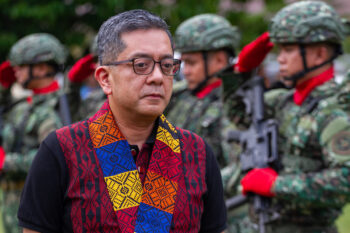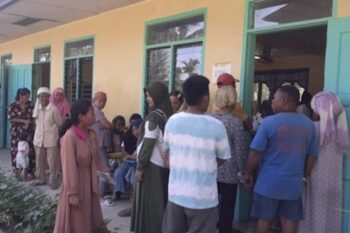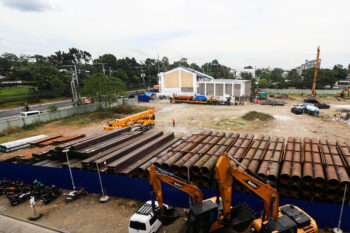NAAWAN, Misamis Oriental (MindaNews / 6 Nov) – Pain and sadness linger as the nation remembers Super Typhoon Yolanda (Haiyan), the deadliest natural disaster in recent memory that struck the country on 08 November 2013, claiming thousands of lives and destroying several billion worth of properties and crops in the Visayas.
On that ominous day unforgiving winds and a lethal storm surge literally wiped out the town of Guiuan in Eastern Samar, the city of Tacloban and other nearby municipalities. One year after, these areas have yet to recover from the devastation. The survivors continue to mourn for the dead and the missing. The footprints of Yolanda in flattened dwellings, destroyed public infrastructures and a blighted environment have remained visible to this day to haunt the nation.
Can we avoid or reduce the deadly consequences of a disaster like Yolanda?
Typhoons are a regularly occurring phenomenon in our country. Our current communication and information facilities can already divine days ahead the occurrence of a typhoon, its direction, its strength and speed, the volume of rain it brings, and the moment of landfall. Moreover, there are areas in the country that are known as typhoon paths, precisely because typhoons visit or pass these places almost predictably. These typhoon paths, notably in southern Luzon and eastern Visayas, have not changed much through the years despite the recent aberration of Typhoon Sendong (2011) in northeastern Mindanao and Typhoon Pablo (2012) in Davao Oriental.
If typhoons in this country are annual happenings, the number of which at times exceeds the letters in the alphabet, and if they are almost 100 percent that predictable in occurrence in certain places, there is no reason why we cannot avoid or reduce their catastrophic consequences. Indeed, while the present level of human knowledge and technology is still far from adequate to stop, divert or slow down raging typhoons, their devastating impacts can certainly be minimized through thorough planning and preparations.
Despite the long string of disasters that this country has experienced through the years, it is only very recent that the national government has confronted the concern squarely with the passage of Republic Act 10121, otherwise known as the Philippine Disaster Risk Reduction and Management Act of 2010.
The legislation mandates critical agencies and instrumentalities of the government like the Army, Navy, Coast Guard, Air Force, the Philippine National Police (PNP), the Department of Science and Technology (DOST), Department of Social Welfare and Development (DSWD) and many others to make necessary plans and preparations and to be ready at all times for any natural or man-made disasters. The preparations of the national government are generally focused in developing plans and warning devices, in warning the nation of an impending disaster, and on responding to the needs of the victims during and immediately after the disaster, say, in rescue operations, in extending immediate relief assistance, and in long-term rehabilitation of affected areas
Needless to say, the major responsibility for any disaster lies in the local government units (LGUs) – at the barangay, municipal/city and provincial government units where the event is expected to happen. The preparation starts with coming up with a disaster risk and management plan, the details of which may include among others the identification of disaster risk areas (risk mapping); coming up with disaster response strategies; public education; formation of warm bodies of responders; identification or establishments of secured evacuation centers; transports and rescue facilities; preparation of emergency food, water, clothing and medical supplies; and providing security and order in evacuation centers and of communities left behind.
In the advent of Yolanda, that is 3 years after the passage of RA 10121, it was evident that both the national and the local governments were ill-prepared for the calamity. The preparation and the overall capacity to respond was no match to the ferocity of the impending disaster.
While the Super Typhoon had been announced several days earlier to be violently strong with the great possibility of an accompanying storm surge, the planners at all levels failed to develop a big picture of what was coming. No one seemed to appreciate the gravity and magnitude of its arrival and impact; hence, the preparation for the monstrous typhoon was obviously at the level of response to previously experienced typhoons in the area. Thus the unthinkable happened.
It did not help that many of the future victims were adamant in leaving their houses and possessions and refused to seek higher grounds or refuge in evacuation centers. A day or two before the typhoon, TV footages showed some people who were decided to remain in their place. They tried to strengthen their dwellings against the storm by installing support poles to their sides, putting weights to the roofing, and tying ropes here and there. Their efforts looked stupid against the blind fury of nature. At the end though the evacuation centers proved inappropriate to the wicked storm and turned into death traps to the hapless evacuees.
The intensity and wickedness of Yolanda, although unmatched in recent history, were not beyond planning and preparation. Good planning, however, ought to be holistic, long-termed and strategic and not just an immediate impulse-like response to an impending event. A good plan, among others, looks back to what had happened in the past – and learn from them – and what will likely happen in times to come taking into serious consideration the incremental physical and social changes in the environment.
Yolanda did not happen for the first time in the Visayas. In his 1668 book “History of the Bisaya People in the Philippines,” Jesuit Francisco Ignacio Alcina, a parish priest whose lifetime assignment was in Samar and Leyte, made observation of a ferocious typhoon in the area where “great waves hurled an average sized ship so far in the forests and left it there… at the top of the trees from which it could hardly be taken down.” He also explained how churches “the largest buildings here were destroyed. The winds chopping them off like one will do to a radish.”
Michael Tan, who shared the foregoing information in his Philippine Daily Inquirer column, suggested that the description could have well applied to Tacloban, what with a number of heavy steel-hulled cargo vessels thrown and remained stranded to this day in some streets of the City on the wake of Yolanda on 08 November 2013. Yolanda was like a repeat performance, a historical déjà vu.
And what we know now as storm surge is not a new phenomenon. Fr. Alcino described the rush of the sea into the land during a typhoon, saying: “The sea enters the domain of the land… For tall mountains of water, which from devastating waves, enter, extend areas of the land.”
Also, on 28 November 1897, the New York Times reported a terrifying typhoon that devastated and killed hundreds in Borongan, Samar and Tacloban on 06 October 1897 and 13 October 1897, respectively. A tidal wave rushed inland for over a mile in Borongan destroying everything along the way. Trading vessels that were on port in Tacloban were, accordingly, crashed ashore by rampaging tidal waves. And 14 years later, that is, on 26 November 1912, another mean typhoon walloped and destroyed Tacloban again as reported by the Washington Herald on 30 November 1912.
There is so much to learn from the past. Ancient as they may be, the information above may yet factor crucially in coming up with comprehensive and rigorous plans to save lives and valuable resources.
(MindaViews is the opinion section of MindaNews. William R. Adan, Ph.D., was a research and extension worker, professor and the first chancellor of the Mindanao State University at Naawan, Misamis Oriental. He was a British Council fellow and trained in 1994 at Sheffield University, United Kingdom, on Participatory Planning and Environmentally Responsible Development. Upon retirement, he served as national consultant to the ADB-DENR project on integrated coastal resource management. He is the immediate past president of the MSU Alumni Association.)







